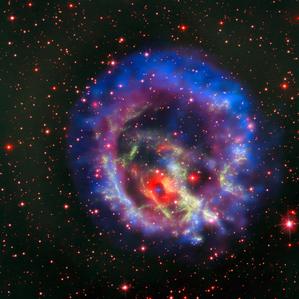Glossary term: 超新星
Description: 超新星是一種大規模的恆星爆發。超新星會短暫地成為星系中迄今為止最明亮的天體,然後在幾年的時間裡逐漸消失。產生超新星的途徑主要有兩種。第一種(Ia 型)是雙星系統中白矮星從伴星吸收物質。一旦白矮星的質量超過 1.4 個太陽質量(錢德拉塞卡極限)或表面積累了足夠多的氦,白矮星就會失去穩定性而爆炸,不留下任何殘餘物。形成超新星(II 型)的另一個主要途徑是質量大於 8 個太陽質量的恆星的演化。在這種恆星演化的末期,它會發生爆炸,形成一顆中子星或(對於質量最大的恆星)恆星級黑洞。
超新星是許多化學元素的來源,尤其是那些比鎂重的元素。
Related Terms:
See this term in other languages
Term and definition status: The original definition of this term in English have been approved by a research astronomer and a teacher The translation of this term and its definition is still awaiting approval
This is an automated transliteration of the simplified Chinese translation of this term
The OAE Multilingual Glossary is a project of the IAU Office of Astronomy for Education (OAE) in collaboration with the IAU Office of Astronomy Outreach (OAO). The terms and definitions were chosen, written and reviewed by a collective effort from the OAE, the OAE Centers and Nodes, the OAE National Astronomy Education Coordinators (NAECs) and other volunteers. You can find a full list of credits here. All glossary terms and their definitions are released under a Creative Commons CC BY-4.0 license and should be credited to "IAU OAE".
If you notice a factual or translation error in this glossary term or definition then please get in touch.
Related Media
大質量恆星的死亡
Credit: ESO/NASA, ESA and Hubble Heritage Team (STScI/AURA)/F.Vogt et al. credit link
License: CC-BY-4.0 Creative Commons 姓名標示 4.0 國際 (CC BY 4.0) icons









